Analyzing Legal and Ethical Violations in Healthcare: A Case Study
VerifiedAdded on 2023/06/14
|6
|1613
|198
Case Study
AI Summary
This case study analyzes the legal, ethical, and regulatory violations of a complementary healthcare practice named "Heal U Natureally Clinik." The clinic's advertisement promised healthy and natural remedies for chronic back pain, assuring adherence to ethical principles. However, the clinic breached several norms, including accessibility issues, privacy violations, lack of informed consent, and unethical behavior towards the patient. The patient's rights, such as the right to consent, refuse care, and access professional experience, were violated. The study suggests actions the patient can take, including filing complaints with local police, government authorities, and social media platforms to address the fraudulent and discriminatory practices observed at the healthcare facility. Desklib provides access to similar case studies and solved assignments for students.
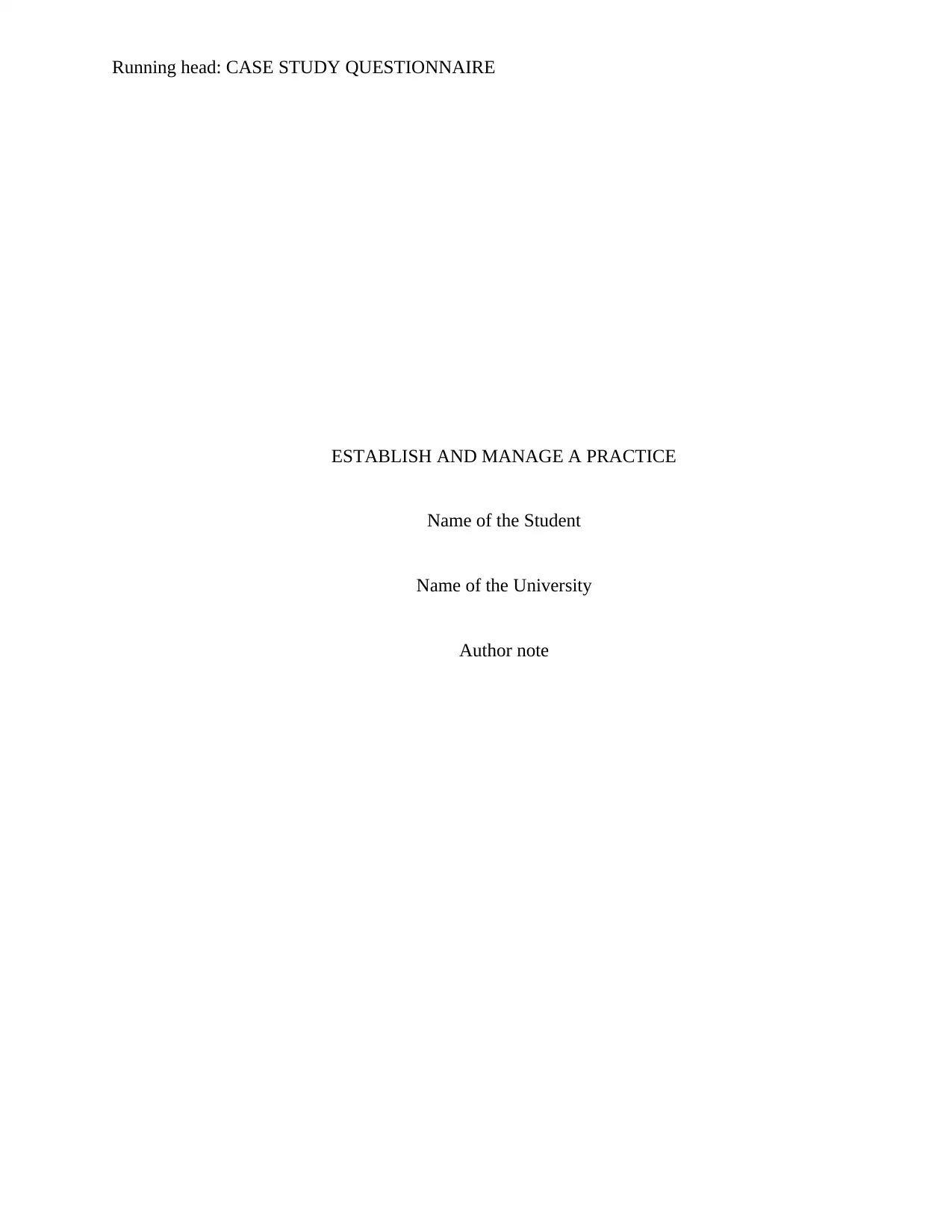
Running head: CASE STUDY QUESTIONNAIRE
ESTABLISH AND MANAGE A PRACTICE
Name of the Student
Name of the University
Author note
ESTABLISH AND MANAGE A PRACTICE
Name of the Student
Name of the University
Author note
Paraphrase This Document
Need a fresh take? Get an instant paraphrase of this document with our AI Paraphraser
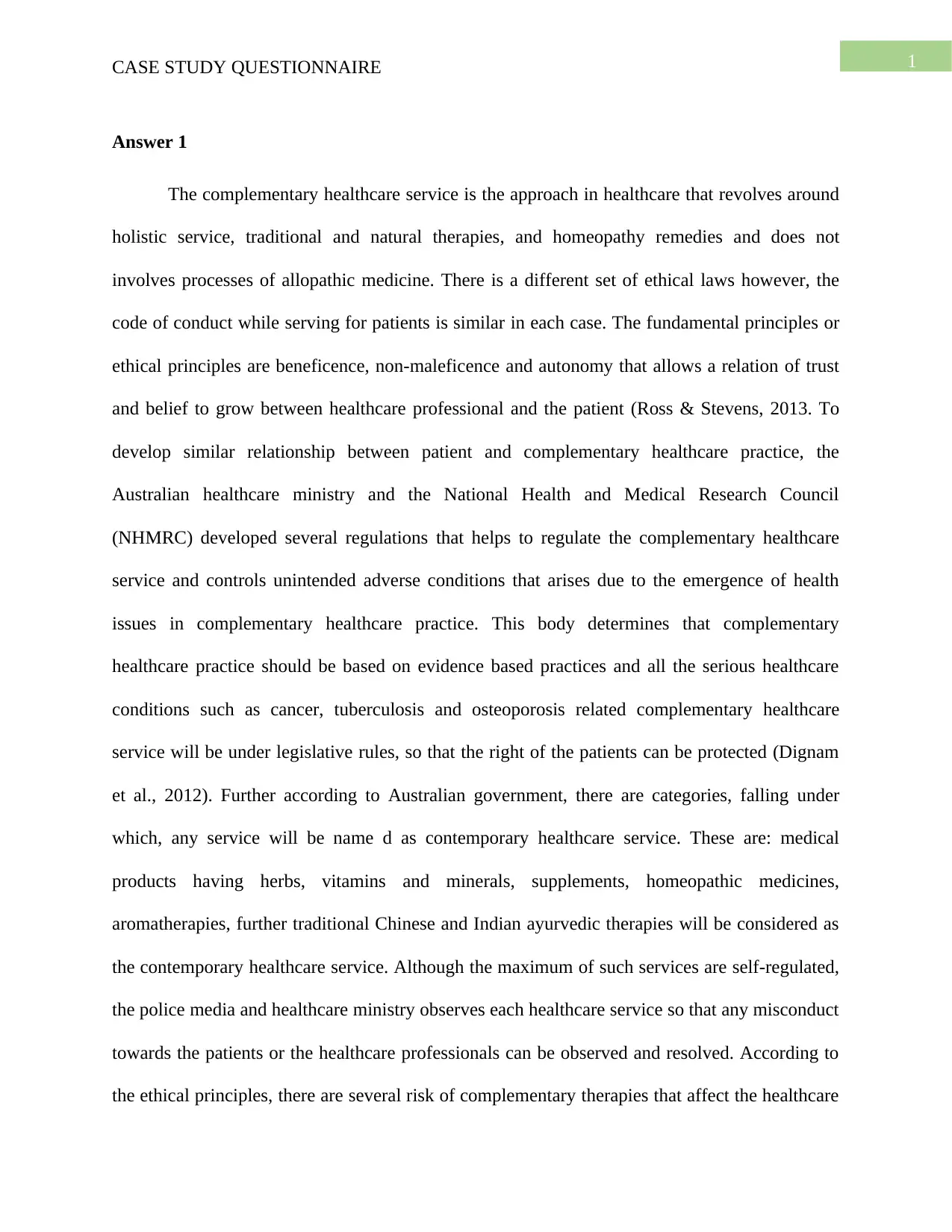
1CASE STUDY QUESTIONNAIRE
Answer 1
The complementary healthcare service is the approach in healthcare that revolves around
holistic service, traditional and natural therapies, and homeopathy remedies and does not
involves processes of allopathic medicine. There is a different set of ethical laws however, the
code of conduct while serving for patients is similar in each case. The fundamental principles or
ethical principles are beneficence, non-maleficence and autonomy that allows a relation of trust
and belief to grow between healthcare professional and the patient (Ross & Stevens, 2013. To
develop similar relationship between patient and complementary healthcare practice, the
Australian healthcare ministry and the National Health and Medical Research Council
(NHMRC) developed several regulations that helps to regulate the complementary healthcare
service and controls unintended adverse conditions that arises due to the emergence of health
issues in complementary healthcare practice. This body determines that complementary
healthcare practice should be based on evidence based practices and all the serious healthcare
conditions such as cancer, tuberculosis and osteoporosis related complementary healthcare
service will be under legislative rules, so that the right of the patients can be protected (Dignam
et al., 2012). Further according to Australian government, there are categories, falling under
which, any service will be name d as contemporary healthcare service. These are: medical
products having herbs, vitamins and minerals, supplements, homeopathic medicines,
aromatherapies, further traditional Chinese and Indian ayurvedic therapies will be considered as
the contemporary healthcare service. Although the maximum of such services are self-regulated,
the police media and healthcare ministry observes each healthcare service so that any misconduct
towards the patients or the healthcare professionals can be observed and resolved. According to
the ethical principles, there are several risk of complementary therapies that affect the healthcare
Answer 1
The complementary healthcare service is the approach in healthcare that revolves around
holistic service, traditional and natural therapies, and homeopathy remedies and does not
involves processes of allopathic medicine. There is a different set of ethical laws however, the
code of conduct while serving for patients is similar in each case. The fundamental principles or
ethical principles are beneficence, non-maleficence and autonomy that allows a relation of trust
and belief to grow between healthcare professional and the patient (Ross & Stevens, 2013. To
develop similar relationship between patient and complementary healthcare practice, the
Australian healthcare ministry and the National Health and Medical Research Council
(NHMRC) developed several regulations that helps to regulate the complementary healthcare
service and controls unintended adverse conditions that arises due to the emergence of health
issues in complementary healthcare practice. This body determines that complementary
healthcare practice should be based on evidence based practices and all the serious healthcare
conditions such as cancer, tuberculosis and osteoporosis related complementary healthcare
service will be under legislative rules, so that the right of the patients can be protected (Dignam
et al., 2012). Further according to Australian government, there are categories, falling under
which, any service will be name d as contemporary healthcare service. These are: medical
products having herbs, vitamins and minerals, supplements, homeopathic medicines,
aromatherapies, further traditional Chinese and Indian ayurvedic therapies will be considered as
the contemporary healthcare service. Although the maximum of such services are self-regulated,
the police media and healthcare ministry observes each healthcare service so that any misconduct
towards the patients or the healthcare professionals can be observed and resolved. According to
the ethical principles, there are several risk of complementary therapies that affect the healthcare
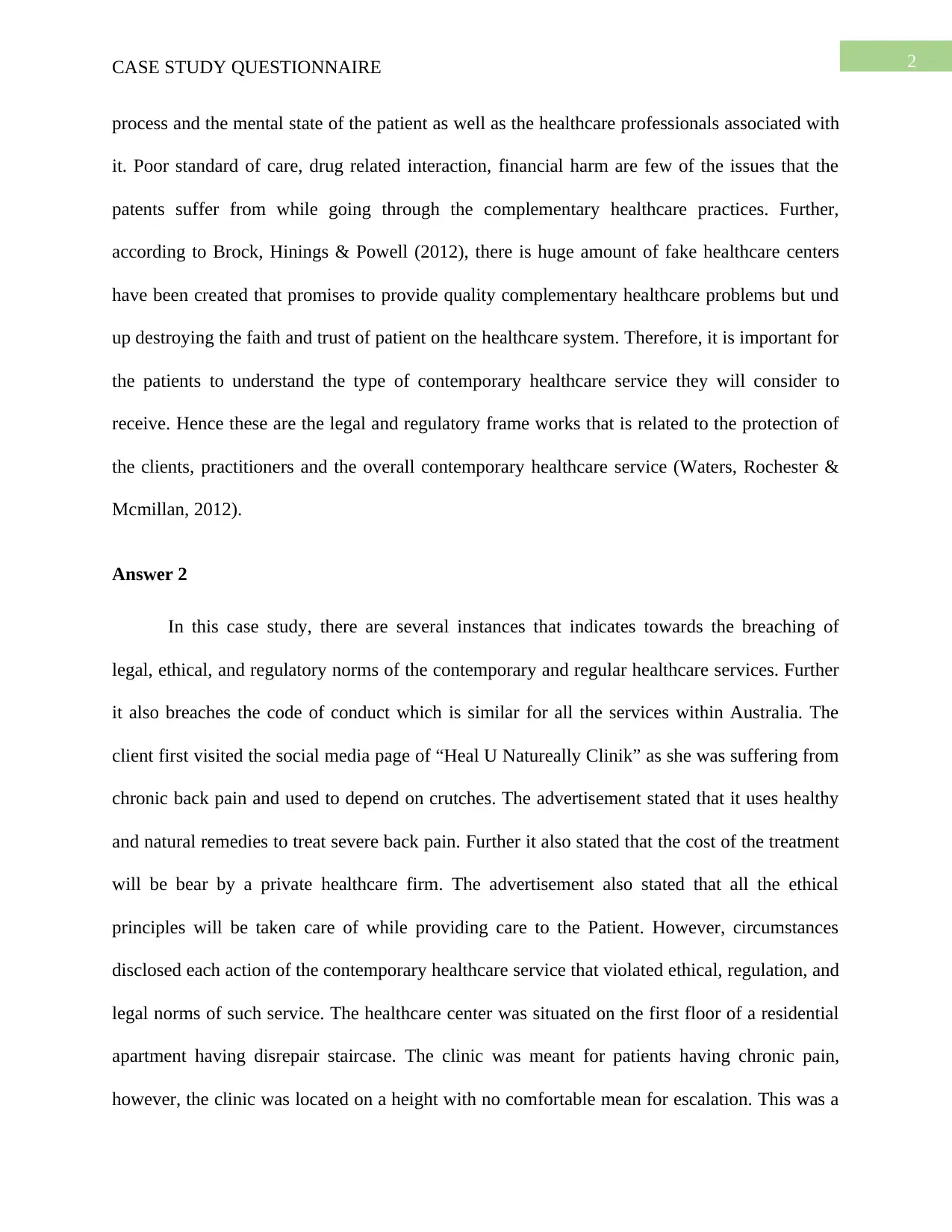
2CASE STUDY QUESTIONNAIRE
process and the mental state of the patient as well as the healthcare professionals associated with
it. Poor standard of care, drug related interaction, financial harm are few of the issues that the
patents suffer from while going through the complementary healthcare practices. Further,
according to Brock, Hinings & Powell (2012), there is huge amount of fake healthcare centers
have been created that promises to provide quality complementary healthcare problems but und
up destroying the faith and trust of patient on the healthcare system. Therefore, it is important for
the patients to understand the type of contemporary healthcare service they will consider to
receive. Hence these are the legal and regulatory frame works that is related to the protection of
the clients, practitioners and the overall contemporary healthcare service (Waters, Rochester &
Mcmillan, 2012).
Answer 2
In this case study, there are several instances that indicates towards the breaching of
legal, ethical, and regulatory norms of the contemporary and regular healthcare services. Further
it also breaches the code of conduct which is similar for all the services within Australia. The
client first visited the social media page of “Heal U Natureally Clinik” as she was suffering from
chronic back pain and used to depend on crutches. The advertisement stated that it uses healthy
and natural remedies to treat severe back pain. Further it also stated that the cost of the treatment
will be bear by a private healthcare firm. The advertisement also stated that all the ethical
principles will be taken care of while providing care to the Patient. However, circumstances
disclosed each action of the contemporary healthcare service that violated ethical, regulation, and
legal norms of such service. The healthcare center was situated on the first floor of a residential
apartment having disrepair staircase. The clinic was meant for patients having chronic pain,
however, the clinic was located on a height with no comfortable mean for escalation. This was a
process and the mental state of the patient as well as the healthcare professionals associated with
it. Poor standard of care, drug related interaction, financial harm are few of the issues that the
patents suffer from while going through the complementary healthcare practices. Further,
according to Brock, Hinings & Powell (2012), there is huge amount of fake healthcare centers
have been created that promises to provide quality complementary healthcare problems but und
up destroying the faith and trust of patient on the healthcare system. Therefore, it is important for
the patients to understand the type of contemporary healthcare service they will consider to
receive. Hence these are the legal and regulatory frame works that is related to the protection of
the clients, practitioners and the overall contemporary healthcare service (Waters, Rochester &
Mcmillan, 2012).
Answer 2
In this case study, there are several instances that indicates towards the breaching of
legal, ethical, and regulatory norms of the contemporary and regular healthcare services. Further
it also breaches the code of conduct which is similar for all the services within Australia. The
client first visited the social media page of “Heal U Natureally Clinik” as she was suffering from
chronic back pain and used to depend on crutches. The advertisement stated that it uses healthy
and natural remedies to treat severe back pain. Further it also stated that the cost of the treatment
will be bear by a private healthcare firm. The advertisement also stated that all the ethical
principles will be taken care of while providing care to the Patient. However, circumstances
disclosed each action of the contemporary healthcare service that violated ethical, regulation, and
legal norms of such service. The healthcare center was situated on the first floor of a residential
apartment having disrepair staircase. The clinic was meant for patients having chronic pain,
however, the clinic was located on a height with no comfortable mean for escalation. This was a
⊘ This is a preview!⊘
Do you want full access?
Subscribe today to unlock all pages.

Trusted by 1+ million students worldwide
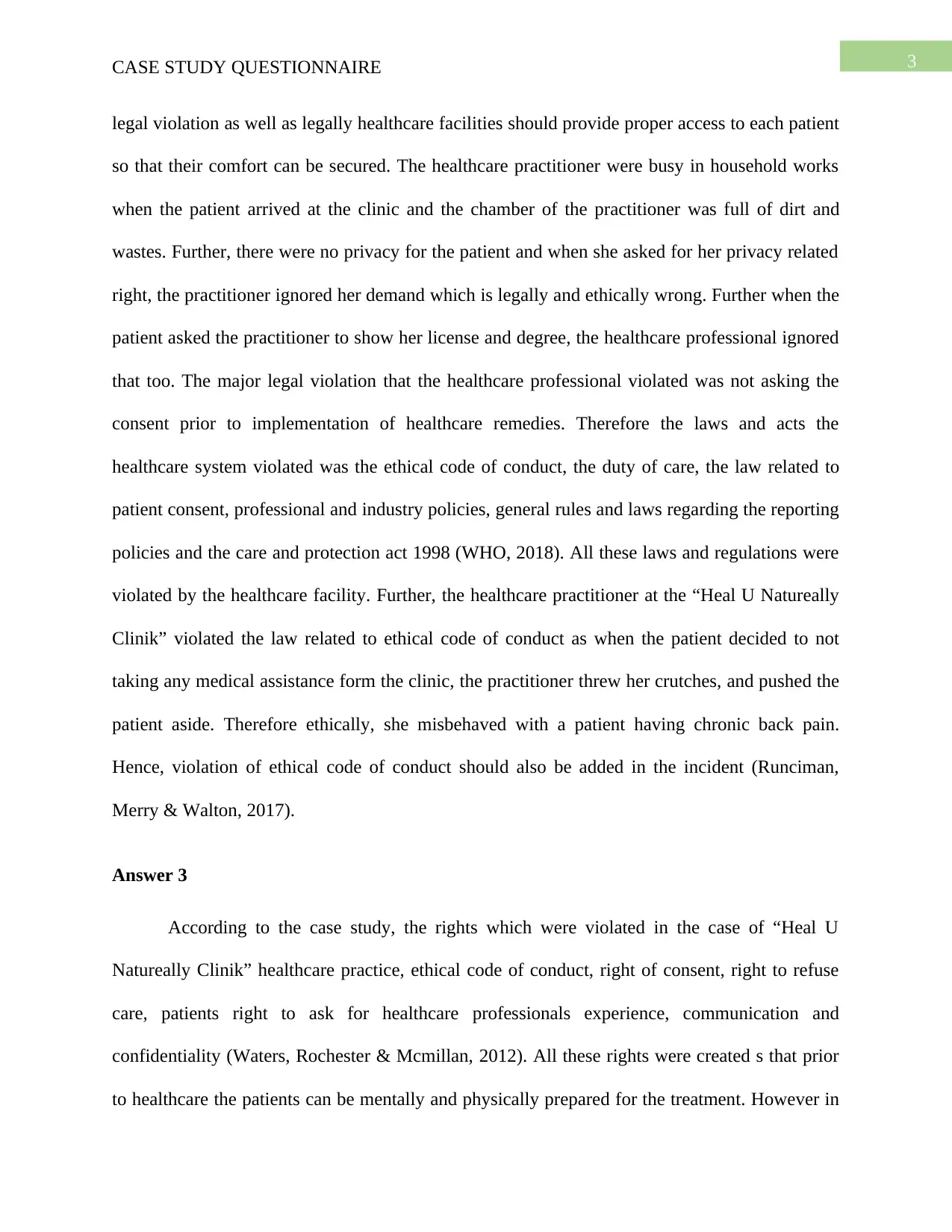
3CASE STUDY QUESTIONNAIRE
legal violation as well as legally healthcare facilities should provide proper access to each patient
so that their comfort can be secured. The healthcare practitioner were busy in household works
when the patient arrived at the clinic and the chamber of the practitioner was full of dirt and
wastes. Further, there were no privacy for the patient and when she asked for her privacy related
right, the practitioner ignored her demand which is legally and ethically wrong. Further when the
patient asked the practitioner to show her license and degree, the healthcare professional ignored
that too. The major legal violation that the healthcare professional violated was not asking the
consent prior to implementation of healthcare remedies. Therefore the laws and acts the
healthcare system violated was the ethical code of conduct, the duty of care, the law related to
patient consent, professional and industry policies, general rules and laws regarding the reporting
policies and the care and protection act 1998 (WHO, 2018). All these laws and regulations were
violated by the healthcare facility. Further, the healthcare practitioner at the “Heal U Natureally
Clinik” violated the law related to ethical code of conduct as when the patient decided to not
taking any medical assistance form the clinic, the practitioner threw her crutches, and pushed the
patient aside. Therefore ethically, she misbehaved with a patient having chronic back pain.
Hence, violation of ethical code of conduct should also be added in the incident (Runciman,
Merry & Walton, 2017).
Answer 3
According to the case study, the rights which were violated in the case of “Heal U
Natureally Clinik” healthcare practice, ethical code of conduct, right of consent, right to refuse
care, patients right to ask for healthcare professionals experience, communication and
confidentiality (Waters, Rochester & Mcmillan, 2012). All these rights were created s that prior
to healthcare the patients can be mentally and physically prepared for the treatment. However in
legal violation as well as legally healthcare facilities should provide proper access to each patient
so that their comfort can be secured. The healthcare practitioner were busy in household works
when the patient arrived at the clinic and the chamber of the practitioner was full of dirt and
wastes. Further, there were no privacy for the patient and when she asked for her privacy related
right, the practitioner ignored her demand which is legally and ethically wrong. Further when the
patient asked the practitioner to show her license and degree, the healthcare professional ignored
that too. The major legal violation that the healthcare professional violated was not asking the
consent prior to implementation of healthcare remedies. Therefore the laws and acts the
healthcare system violated was the ethical code of conduct, the duty of care, the law related to
patient consent, professional and industry policies, general rules and laws regarding the reporting
policies and the care and protection act 1998 (WHO, 2018). All these laws and regulations were
violated by the healthcare facility. Further, the healthcare practitioner at the “Heal U Natureally
Clinik” violated the law related to ethical code of conduct as when the patient decided to not
taking any medical assistance form the clinic, the practitioner threw her crutches, and pushed the
patient aside. Therefore ethically, she misbehaved with a patient having chronic back pain.
Hence, violation of ethical code of conduct should also be added in the incident (Runciman,
Merry & Walton, 2017).
Answer 3
According to the case study, the rights which were violated in the case of “Heal U
Natureally Clinik” healthcare practice, ethical code of conduct, right of consent, right to refuse
care, patients right to ask for healthcare professionals experience, communication and
confidentiality (Waters, Rochester & Mcmillan, 2012). All these rights were created s that prior
to healthcare the patients can be mentally and physically prepared for the treatment. However in
Paraphrase This Document
Need a fresh take? Get an instant paraphrase of this document with our AI Paraphraser
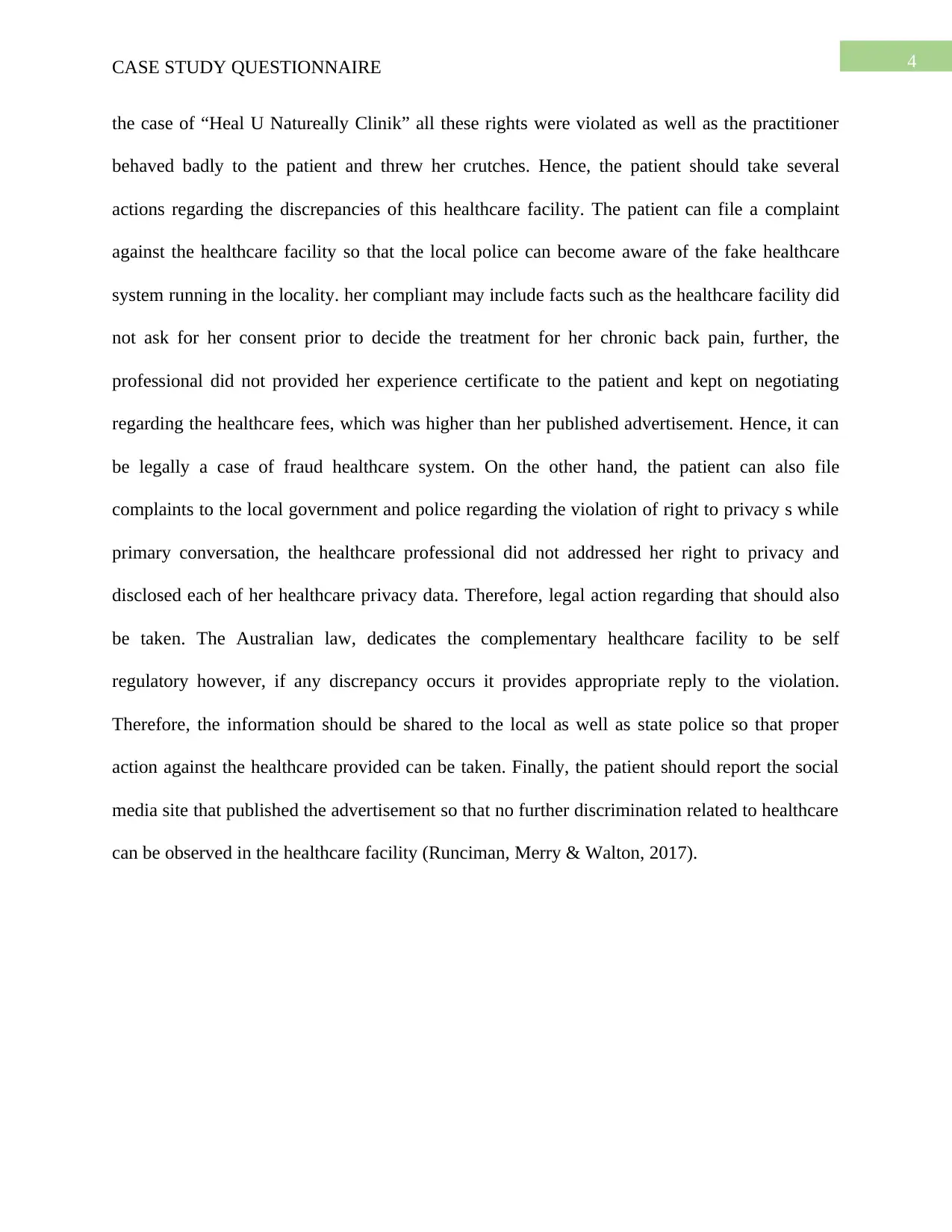
4CASE STUDY QUESTIONNAIRE
the case of “Heal U Natureally Clinik” all these rights were violated as well as the practitioner
behaved badly to the patient and threw her crutches. Hence, the patient should take several
actions regarding the discrepancies of this healthcare facility. The patient can file a complaint
against the healthcare facility so that the local police can become aware of the fake healthcare
system running in the locality. her compliant may include facts such as the healthcare facility did
not ask for her consent prior to decide the treatment for her chronic back pain, further, the
professional did not provided her experience certificate to the patient and kept on negotiating
regarding the healthcare fees, which was higher than her published advertisement. Hence, it can
be legally a case of fraud healthcare system. On the other hand, the patient can also file
complaints to the local government and police regarding the violation of right to privacy s while
primary conversation, the healthcare professional did not addressed her right to privacy and
disclosed each of her healthcare privacy data. Therefore, legal action regarding that should also
be taken. The Australian law, dedicates the complementary healthcare facility to be self
regulatory however, if any discrepancy occurs it provides appropriate reply to the violation.
Therefore, the information should be shared to the local as well as state police so that proper
action against the healthcare provided can be taken. Finally, the patient should report the social
media site that published the advertisement so that no further discrimination related to healthcare
can be observed in the healthcare facility (Runciman, Merry & Walton, 2017).
the case of “Heal U Natureally Clinik” all these rights were violated as well as the practitioner
behaved badly to the patient and threw her crutches. Hence, the patient should take several
actions regarding the discrepancies of this healthcare facility. The patient can file a complaint
against the healthcare facility so that the local police can become aware of the fake healthcare
system running in the locality. her compliant may include facts such as the healthcare facility did
not ask for her consent prior to decide the treatment for her chronic back pain, further, the
professional did not provided her experience certificate to the patient and kept on negotiating
regarding the healthcare fees, which was higher than her published advertisement. Hence, it can
be legally a case of fraud healthcare system. On the other hand, the patient can also file
complaints to the local government and police regarding the violation of right to privacy s while
primary conversation, the healthcare professional did not addressed her right to privacy and
disclosed each of her healthcare privacy data. Therefore, legal action regarding that should also
be taken. The Australian law, dedicates the complementary healthcare facility to be self
regulatory however, if any discrepancy occurs it provides appropriate reply to the violation.
Therefore, the information should be shared to the local as well as state police so that proper
action against the healthcare provided can be taken. Finally, the patient should report the social
media site that published the advertisement so that no further discrimination related to healthcare
can be observed in the healthcare facility (Runciman, Merry & Walton, 2017).
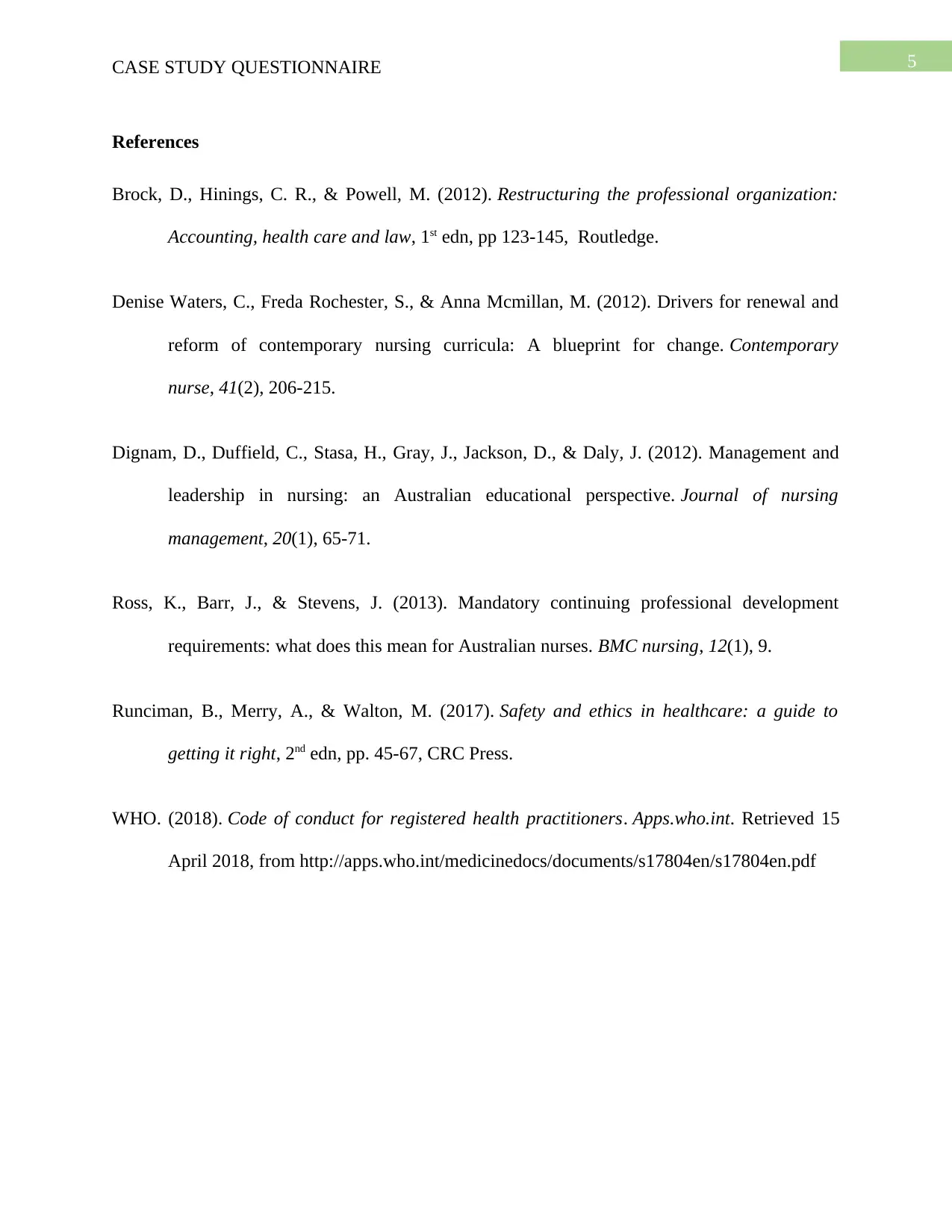
5CASE STUDY QUESTIONNAIRE
References
Brock, D., Hinings, C. R., & Powell, M. (2012). Restructuring the professional organization:
Accounting, health care and law, 1st edn, pp 123-145, Routledge.
Denise Waters, C., Freda Rochester, S., & Anna Mcmillan, M. (2012). Drivers for renewal and
reform of contemporary nursing curricula: A blueprint for change. Contemporary
nurse, 41(2), 206-215.
Dignam, D., Duffield, C., Stasa, H., Gray, J., Jackson, D., & Daly, J. (2012). Management and
leadership in nursing: an Australian educational perspective. Journal of nursing
management, 20(1), 65-71.
Ross, K., Barr, J., & Stevens, J. (2013). Mandatory continuing professional development
requirements: what does this mean for Australian nurses. BMC nursing, 12(1), 9.
Runciman, B., Merry, A., & Walton, M. (2017). Safety and ethics in healthcare: a guide to
getting it right, 2nd edn, pp. 45-67, CRC Press.
WHO. (2018). Code of conduct for registered health practitioners. Apps.who.int. Retrieved 15
April 2018, from http://apps.who.int/medicinedocs/documents/s17804en/s17804en.pdf
References
Brock, D., Hinings, C. R., & Powell, M. (2012). Restructuring the professional organization:
Accounting, health care and law, 1st edn, pp 123-145, Routledge.
Denise Waters, C., Freda Rochester, S., & Anna Mcmillan, M. (2012). Drivers for renewal and
reform of contemporary nursing curricula: A blueprint for change. Contemporary
nurse, 41(2), 206-215.
Dignam, D., Duffield, C., Stasa, H., Gray, J., Jackson, D., & Daly, J. (2012). Management and
leadership in nursing: an Australian educational perspective. Journal of nursing
management, 20(1), 65-71.
Ross, K., Barr, J., & Stevens, J. (2013). Mandatory continuing professional development
requirements: what does this mean for Australian nurses. BMC nursing, 12(1), 9.
Runciman, B., Merry, A., & Walton, M. (2017). Safety and ethics in healthcare: a guide to
getting it right, 2nd edn, pp. 45-67, CRC Press.
WHO. (2018). Code of conduct for registered health practitioners. Apps.who.int. Retrieved 15
April 2018, from http://apps.who.int/medicinedocs/documents/s17804en/s17804en.pdf
⊘ This is a preview!⊘
Do you want full access?
Subscribe today to unlock all pages.

Trusted by 1+ million students worldwide
1 out of 6
Related Documents
Your All-in-One AI-Powered Toolkit for Academic Success.
+13062052269
info@desklib.com
Available 24*7 on WhatsApp / Email
![[object Object]](/_next/static/media/star-bottom.7253800d.svg)
Unlock your academic potential
Copyright © 2020–2025 A2Z Services. All Rights Reserved. Developed and managed by ZUCOL.





